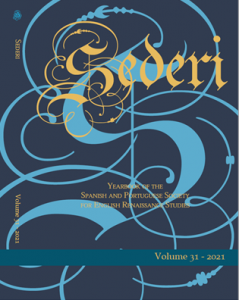
Sederi 30
Sederi 31 — 2021
EDITOR
Ana Sáez-Hidalgo
MANAGING EDITORS
Marta Cerezo Moreno
Isabel Guerrero Llorente
REVIEW EDITOR
Miguel Ramalhete
ISSN 1135-7789
José Ruiz Mas. “English travelers in early modern Cyprus: Piety, commerce and anti-Ottoman sentiment.” SEDERI 31 (2021): 93–115.
DOI: https://doi.org/10.34136/sederi.2021.5 Download PDF
Abstract
English travelers in Lusignan and Venetian Cyprus saw the island as the last obligatory stop on their maritime pilgrimage route to the Holy Land. After the Ottoman conquest of Cyprus (1571) the island was visited almost exclusively by English merchants on the lookout for the construction of factories on Eastern Mediterranean shores. They were attracted by Cyprus’s famed fertility and by the abundance of much-valued products to trade with. In the sixteenth and seventeenth centuries English traders were nevertheless issued with warnings by English travel accounts. These dealt with the danger of over-trusting the paradise-like prospects of the island and remaining there for good, with the subsequent risk of “turning Turk.” In order to discourage English travelers and residents from becoming renegades in Cyprus, travel accounts included abundant morbid information on the brutal repression applied by the Great Turk upon Cypriot cities in the Wars of Cyprus and upon other anti-Ottoman Christian insurrections.
Keywords: Travel accounts; Cyprus; Holy Land; English pilgrims; English merchants; Ottoman occupation of Cyprus.
References
Aldersey, Laurence. 1889. “The first voyage or iorney, made by Master Laurence Aldersey, Marchant of London, to the Cities of Ierusalem, and Tripolis, &c. in the yeere 1581. Penned and Set Downe by himself.” In Richard Hakluyt, Principal Navigations, Voyages, Traffiques, and Discoveries of the English Nation, vol. IX, no. 2, 150–154. Edinburgh: E. and G. Goldsmid.
Aune, M. G. 2005. “Early Modern European Travel Writing after Orientalism,” Journal of Early Modern Cultural Studies 5, no. 2: 120–138.
Bekkaoui, Khalid. 2018. “Piracy, Diplomacy, and Cultural Circulation in the Mediterranean.” In Piracy and Captivity in the Mediterranean 1550–1810, edited by Mario Klarer, 186–198. Abingdon, Oxon: Routledge.
Bennet, Josephine. 1954. The Rediscovery of Sir John Mandeville. New York: MLA.
Bent, James Theodore, ed. (1893) 2010. Early Voyages and Travels in the Levant. I. The Diary of Master Thomas Dallam 1599–1600. II. Extracts from the Diaries of Dr John Covel, 1670–1679. With some Account of the Levant Company of Turkey merchants. London: Routledge.
Burton, Jonathan. 2002. “English Anxiety and the Muslim Power of Conversion: Five Perspectives on ‘Turning Turk’ in Early Modern Texts.” Journal for Early Modern Cultural Studies 2, no. 1: 35–67.
Brotton, Jerry. 2016. The Oriental Isle. Elizabethan England and the Islamic World. London: Allen Lane.
Carey, Daniel and Claire Jowitt, eds. 2012. Richard Hakluyt and Travel Writing in Early Modern Europe. Farnham and Burlington, VT: Ashgate.
Cobham, Claude Delaval. (1908) 1986. Excerpta Cypria. Materials for a History of Cyprus. With an Appendix on the Bibliography of Cyprus. Cambridge: Cambridge University Press.
Coryat, Thomas. (1611) 1905. Coryat’s crudities: hastily gobled up in five moneths travells in France, Savoy, Italy, Rhetia commonly called the Grisons country, Helvetia alias Switzerland, some parts of high Germany and the Netherlands. Glasgow: James MacLehose and Sons.
Coureas, Nicholas and Andreas G. Orphanides. 2007. “Piracy in Cyprus and the Eastern Mediterranean during the Later Lusignan and Venetian Periods (15th–16th Centuries),” Eπετηρίδα του Κέντρου Επιστηµονικών Ερευνών XXXIII: 121–162.
Foster, Tara. 2005. “Clemence of Barking: Reshaping the Legend of Saint Catherine of Alexandria,” Women’s Writing 12, no.1: 13–27.
Groves, Beatrice. 2012. “‘Those sanctified places where our Sauiours feete had trode’: Jerusalem in Early Modern English Travel Narratives,” Sixteenth Century Journal 43, no. 3: 681–700.
Hakluyt, Richard. (1599) 1885–1890. The Principal Navigations, Voyages, Traffiques, and Discoveries of the English Nation. Edited by Edmund Goldsmid. 12 vols. Edinburgh: E. and G. Goldsmid.
Harvey, P. D. A. 2012. Medieval Maps of the Holy Land. London: British Library.
Jeffery, George. 1918. A Description of the Historic Monuments of Cyprus. Studies in the Archæology and Architecture of the Island with Illustrations from Measured Drawings and Photographs. Nicosia: William James Archer, Government Printing Office.
Jennings, Ronald. 1992. Christians and Muslims in Ottoman Cyprus and the Mediterranean World, 1571–1640. New York: New York University Press.
Kuehn, Julia and Paul Smethurst, eds. 2009. Travel Writing, Form and Empire. New York: Routledge.
Lithgow, William. (1632) 1974. The Rare Adventures and Painful Peregrinations of William Lithgow. Edited by Gilbert Phelps. London: The Folio Society.
Locke, John. 1889. “The Voyage of M. Iohn Locke to Jerusalem.” In Richard Hakluyt, The Principal Navigations, Voyages, Traffiques, and Discoveries of the English Nation, vol. XI, no. 51, 102–110. Edinburgh: E. and G. Goldsmid.
Matar, Nabil. 2000. Turks, Moors and Englishmen in the Age of Discovery. Columbia: Columbia University Press.
McLean, Gerald and Nabil Matar. 2011. Britain and the Islamic World 1558–1713. Oxford: Oxford University Press.
Moryson, Fynes. (1617) 1907–1908. An Itinerary: Containing His Ten Years Travel Through the Twelve Dominions of Germany, Bohemia, Switzerland, Netherland, Denmark, Poland, Italy, Turkey, France, England, Scotland and Ireland. Glasgow: J. MacLehose and Sons.
Nesvet, Rebecca. 2006. “Martinengo’s ‘Grecians’ and Shakespeare’s Cyprus.” In Shakespeare and Montaigne Revisited, The Shakespeare International Yearbook, edited by G. Bradshaw, T. Bishop and P. Holbrook, 280–310. London: Ashgate.
Ruiz Mas, José. 2011. “The Image of the Great Turk after the Ottoman Conquest of Famagusta and Marc Antonio Bragadino’s Martyrdom: From its Genesis in the Anti-Turkish Propaganda of Venetian Narratives and Chronicles to its Impact in English Literature.” In Strangers in Early Modern English Texts, edited by Jesús López-Peláez, 171–190. Frankfurt am Main: Peter Lang.
Ruiz Mas, José. 2013. “Another Brick in the Wall of the Turkish Black Legend: The Fall of Nicosia and its Impact in English Literature.” In The Construction of the Other in Early Modern Britain: Attraction, Rejection, Symbiosis, edited by Rüdiger Ahrens, 189–204. Heidelberg: Universitätsverlag Winter GmbH Heidelberg.
Rycaut, Paul. 1679. The Present State of the Greeks and Armenian Churches Anno Christi 1678 Written at the Command of His Majesty by Paul Ricaut. London: John Starkey.
Sanderson, John. 1931. The Travels of John Sanderson in the Levant, 1584–1602, with his Autobiography and Selections from his Correspondence. Edited by Sir William Foster. London: Hakluyt Society.
Sandys, George. (1615) 1621. Relation of a Iourney begun An. Dom. 1610. Fovre Bookes. Containing a description of the Turkish Empire, of Ægypt, of the Holy Land, of the remote parts of Italy, and ilands adionyning. 2nd edn. London: W. Barrett.
Seymour, M. C. 1993. Sir John Mandeville. Aldershot: Variorum.
Snoek, G. J. C. 1995. Medieval Piety from Relics to the Eucharist: A Process of Mutual Interaction. Leiden: Brill.
Stanivukovic, Goran V., ed. 2007. Remapping the Mediterranean World in Early Modern English Writings. New York: Palgrave Macmillan.
Suranyi, Anna. 2002. The Genius of the English Nation: Travel Writing and National Identity in Early Modern English. Newark: University of Delaware Press.
Tyerman, C. 1985. “England and the Crusades.” In Crusade and Settlement. Papers read at the First Conference of the Society for the Study of the Crusades and the Latin East and presented to R. C. Smail, edited by Peter W. Edbury, 147–149. Cardiff: University College Cardiff Press.
Valente, Claire. 1995. “Simon de Monfort, Earl of Leicester, and the Utility of Sanctity in Thirteenth Century England,” Journal of Medieval History 21, no. 1: 27–49.
Vitkus, Daniel J. 2001. “Trafficking with the Turk: English Travelers in the Ottoman Empire during the Early Seventeenth Century.” In Travel Knowledge: European “Discoveries” in the Early Modern Period, edited by Ivo Kamps and Jyotsna G. Singh, 35–52. New York: Palgrave.
Vitkus, Daniel and Nabil Matar, eds. 2001. Piracy, Slavery, and Redemption: Barbary Captivity Narratives from Early Modern England. New York: Columbia University Press.
Walsham, Alexandra. 2010. “Footprints and Faith: Religion and the Landscape in Early Modern Britain and Ireland.” In God’s Bounty. The Churches and the Natural World, edited by Peter Clarke and Tony Claydon, 169–183. Woodbridge: Ecclesiastical History Society.
Wey, William. 1857. The Itineraries of William Wey, Fellow of Eton College. To Jerusalem, A.D. 1458 and A.D. 1462; and to Saint James of Compostella, A.D. 1456. From the Original Manuscript in the Bodleian Library, 2 vols. Printed for the Roxburghe Club. London: J. B. Nichols and Sons.
Wogan-Browne, Jocelyn, and Glyn S. Burgess, eds. and trans. 1996. Virgin Lives and Holy Deaths: Two Exemplary Biographies for Anglo-Norman Women. London: Dent/Everyman.
